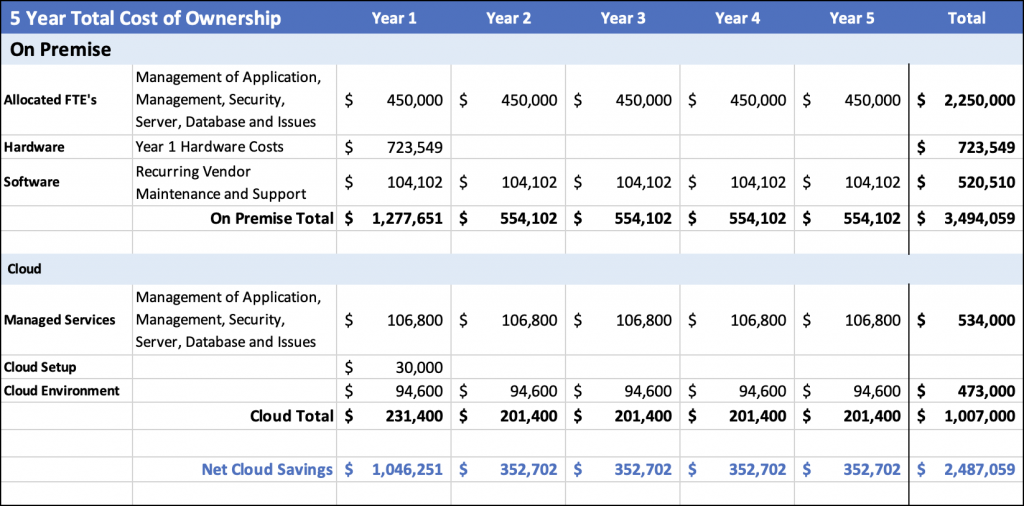I am often asked by clients how the cost of a cloud deployment for a typical commodity trading and risk management (“CTRM”) solution compares to on-premises deployment when our teams are discussing the merits of cloud based deployment. While cost is always an interesting and important benchmark, it is important to understand the desired capabilities and flexibility in and around the management of servers that is required for not only the end state production solution, but also for the project team using these environments to configure and deploy the CTRM software.
Data Portability
During many project deployments, client teams will require the rapid movement of data from various environments throughout the lifecycle of a project. For a typical CTRM deployment, our team will use a minimum of three environments for development, user acceptance testing, and training, in preparation for the deployment into production. Depending upon the size of the organization and deployment team, additional environments may be needed to support the efficient testing of new configurations or software patches. In some cases, a project team is tasked to rapidly clone environments at a moment’s notice based on a critical hot patch, configuration change, or an extension testing request. Cloud virtualization solutions are native to both AWS and Azure and provide the ability to instantly “clone” the virtual machines where test activities are being run by a project. Using an Amazon AWS AMI or Azure VM Image capture functionality, system administrators can rapidly duplicate an instance in just a matter of minutes. Gone are the days where project teams are on standby awaiting an in-house infrastructure support team to find a server, install new software, confirm configuration settings, and finally restore data from a backup, just to create a new temporary instance for an urgent testing effort. This rapid flexibility can be extended to the business to enable the rapid testing of new configuration(s) with minimal wait times. This level of data portability and flexibility offered by cloud technology providers simply can’t be offered in a cost-effective way by most in house IT organizations.
Disaster Recovery and High Availability
Most clients will typically deploy mission critical applications such as market bid tools, market data repositories, and CTRM systems in highly available (HA) configurations. In this mode of operation, production transactional data is replicated in real time to a hot stand-by database that in the event of a detectable hardware failure, enables a quick recovery of the application. Both Amazon AWS and Microsoft Azure offer a multitude of solutions to enable not only HA, but also geographic diversity in the resulting fail-over solution. By simply selecting a data center in another state (or country), an extra measure of safety is built into the design that enables not only fail-over to another standby host, but a standby host that is replicated into another data center. Once again, this level of fail-over is cost prohibitive and not possible for organizations that attempt the on-premises hosting of mission critical applications.
Scalability and Performance
Solutions today must be able to dynamically adjust as the needs of a client changes. Adding additional trading resources, physical assets, or even new commodity types will increase the load on the virtual machines running the CTRM solution. Cloud vendor solutions provide a near “limitless” upgrade path so additional storage, memory, or virtual CPU increases are simply a mouse click away. The process of sizing the hardware for a given CTRM solution must be precise to make sure that the right amount of hardware is correctly procured prior to go-live, as it is not economically feasible to create an “inventory” of locally hosted hardware that is on standby. The flexibility provided by the cloud not only makes technical deployment an easier task but reduces the total cost of ownership as customers can effectively rent what they need, when they need it.
As you can see in the example below, the 5-year total cost savings can be substantial when leveraging the power of cloud-based solutions in-lieu of on-premise data center solutions.


Concluding Thoughts
In closing, the rapid expansion of cloud computing has been a strategic “game changer” for our clients running enterprise wide CTRM applications. Gone are the days where projects are delayed because of a missing power cable, need for an extra network interface card, or because the “IT guy” is on vacation. It is incredibly difficult to beat the flexibility, expandability, and safety that cloud based deployments provide for our industry.

